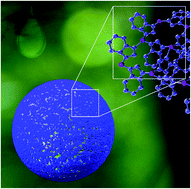Two-dimensional MOF-based liquid marbles: surface energy calculations and efficient oil–water separation using a ZIF-9-III@PVDF membrane†
Abstract
Superhydrophobic MOF-nanosheets assembled on the outside of an aqueous droplet form ‘liquid marbles’. A facile mechanochemical-based synthesis followed by ultrasonication was used to prepare two-dimensional superhydrophobic–oleophilic MOF nanosheets of a Co2+-based zeolitic imidazolate framework, namely ZIF-9-III ([Co4(bIm)16] with bIm− = benzimidazolate). The resulting ZIF-9-III showed excellent hydrophobicity (advancing water contact angle of 144°) and oleophilicity (oil contact angle of ≈0°). The superhydrophobic behavior originated from its predominant outer (002) surface, which featured nanoscale corrugation caused by the exposed benzimidazole groups. This behavior was corroborated by inverse gas chromatography measurements to determine the surface energies of bulk exfoliated 2D ZIF-9-III nanosheets and 3D ZIF-9-I. Taking advantage of the unique surface properties, including low surface energy and good moisture stability, we prepared ZIF-9-III@PVDF (PVDF = polyvinylidene fluoride) membranes following the non-solvent induced phase inversion (NIPS) process. The resulting membranes were exploited in real-time oil/water separation and featured remarkably high adsorption capacity and anti-staining properties. Therefore, this work opens the door to developing new superhydrophobic MOF-based composite materials with permeant porosity, which may enable applications in self-cleaning membranes for oil–water separation.



 Please wait while we load your content...
Please wait while we load your content...